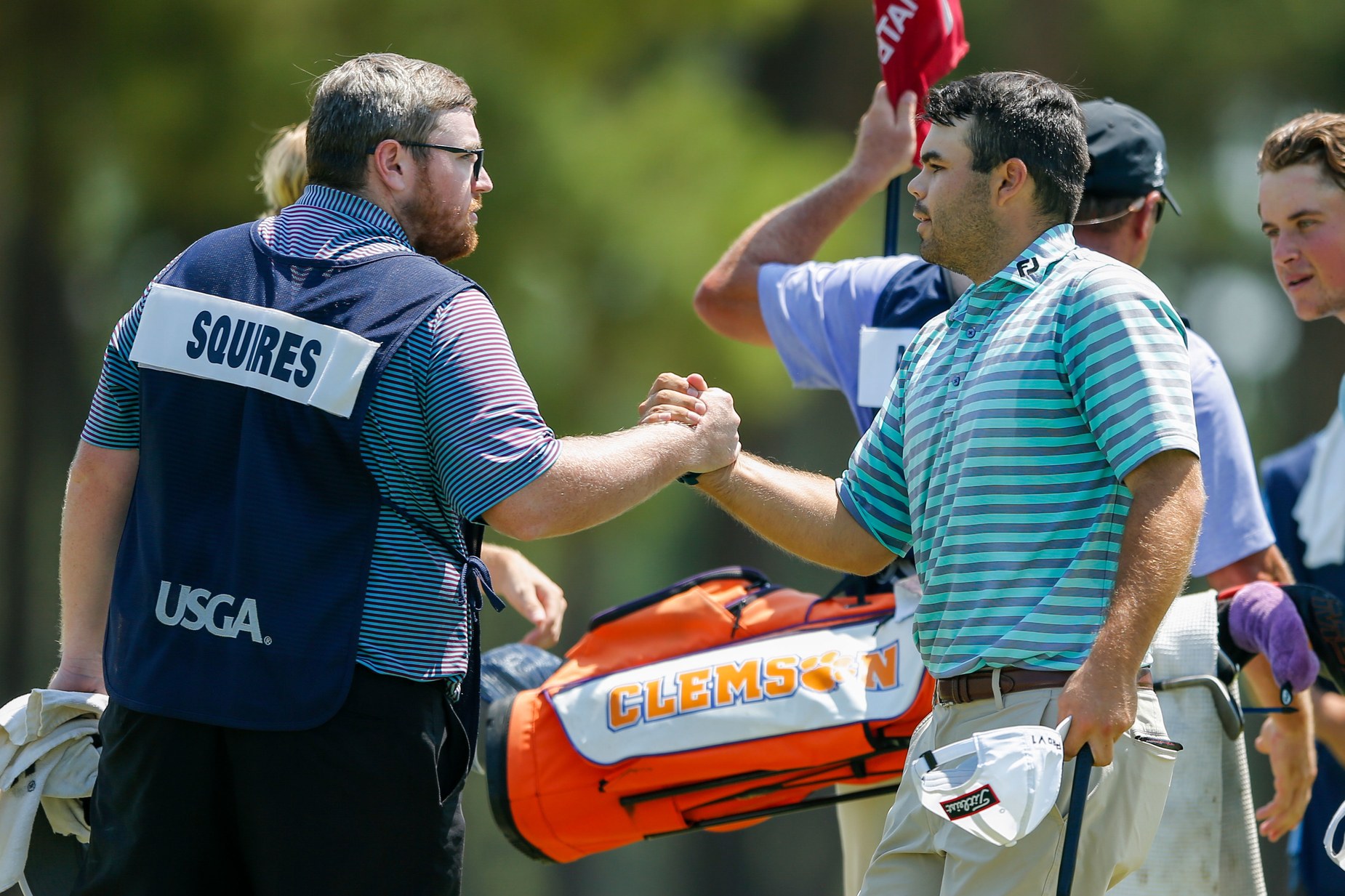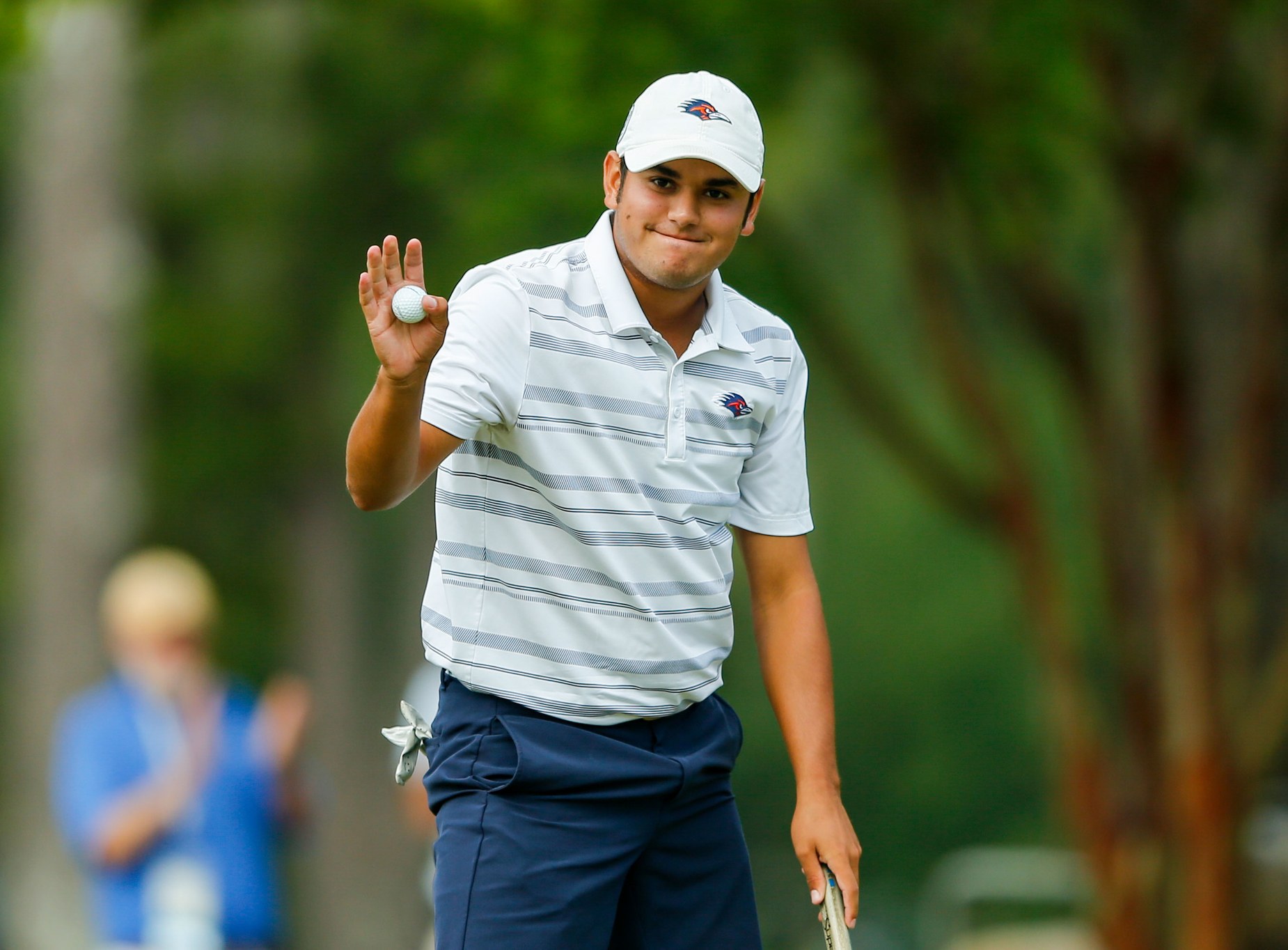It took 3 hours, 46 minutes for Austin Squires to play four holes of golf on Wednesday morning/afternoon at the US Amateur Championship. Before you close your browser, rest assured this isn’t another story harping on the ills of slow play. No, this is about something far more wonky. This is a story celebrating one of the most idiosyncratic aspects of one of the most underappreciated tournaments in golf.
As it turned out, 3 hours, 46 minutes was the time needed for the 22-year-old from Union, Kentucky, a recent University of Cincinnati graduate, to clinch the third and final spot into the match-play field and conclude a 27-player-for-3-spots playoff at Pinehurst Resort. Those 3 hours, 46 minutes, played in the sticky North Carolina air, were packed with a potpourri of emotions. There was joy and heartbreak, anxiousness and frustration, disappointment and relief.
Oh, and there was a lot of waiting around. But for the hearty souls who went the distance, it was also oddly fulfilling.
• • •
It’s best to start with some background: The playoff to whittle down the 312 players competing in the US Amateur to the 64 golfers advancing to match play has become part of the fabric of the championship. Just twice since this format was adopted in 1979 has there NOT been a playoff (in 1985 and 2000 the golf gods somehow magically devined that a perfect 64 golfers would separate themselves without the need of extra golf). The only question facing USGA officials is how many players and how many spots.
Knowing the inevitable, the folks in charge of the championship have made some concessions over the years to control the chaos. “We’ve ended any notion of trying to end it on Tuesday,” said Robbie Zalzneck, director of the US Amateur Championship. “It’s just logistically too difficult.”
Mind you, a playoff to advance to match play into the US Amateur is no trivial thing. This is not determining a consolation prize. Just ask Doc Redman, who got through the 13-player-for-8-spot playoff in 2017 at Riviera Country Club and went on to win the championship. Back in 2012 at Cherry Hills Country Club, both the champion, Steven Fox, and the runner-up, Michael Weaver, were playoff survivors in a 17-for-14 contest.
What made this year’s edition more complicated than usual is that bad weather on Tuesday afternoon prevented everyone from finishing their 36 holes of stroke-play qualifying by nightfall. A few dozen players needed to return to the No.2 and No.4 courses on Wednesday, resuming play at 7:20am.
Among them was Chad Sewell. The rising junior at UT-San Antonio had three holes remaining on No.2, and needed to make three pars to assure himself of getting into the match-play field. He parred the first two, then had 20 feet for birdie on this third … only to three-putt the hole. “I was just stunned,” Sewell said.
It turns out, there were a few other similar mishaps, and because of that, the cut moved from the overnight number of four-over par to five-over par, with 27 players who had been hitting refresh on their phones all morning happy to see their US Amateur dreams weren’t done just yet.
Among them was Kevin O’Connell, the reigning US Mid-Amateur champion. O’Connell had finished his second round of stroke play on Tuesday, and walked away from Pinehurst convinced he had missed the cut by a stroke or two. He even checked out of his Pinehurst hotel and stayed with his wife at his parents’ house just down the road in Cary, North Carolina. But he returned in plenty of time to join his fellow playoff participants.

• • •
When it comes to organising a match-play elimination playoff, well it’s a bit like herding cats. To help with the communication, the USGA has the mobile numbers for all 312 players, according to Zalzneck, and sends an alert to everyone that explains exactly what’s happening. A message went out Tuesday night, then again when stroke play finally ended on Wednesday morning.
The playoff was set to begin at 9:15am on the first hole at Pinehurst No.4, a 450-yard par 4. It started with a threesome of players, then six foursomes each teeing off 11 minutes apart. All 27 players had to complete the hole before any additional holes could be played, in order to determine how many people remained. This guaranteeing the playoff would last at least 90 minutes to get everyone through the hole.
All three players in the first group made pars, which meant that anybody making five or higher among the golfers still to play would be eliminated from the playoff.
Van Holmgren was in the second group. When he holed a 20-foot birdie putt, the 20-year-old college golfer at North Dakota State knew he was pretty sure to advance to the next hole. Yet as subsequent groups completed the hole, and nobody was posting better than par, Holmgren’s birdie started looking better and better.
There were a few fairly big names among the amateur ranks in the playoff. In addition to O’Connell, there was Jovan Rebula, the 2018 British Amateur champion; Cole Hammer, the No.1 ranked amateur in the world entering the event; and Alex Smalley (a 2017 US Open qualifier and All-American golfer at Duke). None of them, however, could match Holmgren. O’Connell and Rebula made a par, and Hammer and Smalley made bogeys (Hammer’s drive landed in a divot hole and his approach left him a 35-footer for birdie. He raced the putt three feet by and missed the comebacker to frustratingly end his week early.)
It wasn’t until the final foursome played the first hole that a second golfer made a birdie. Sewell, who had waited nearly two hours to get back on the course after his three-putt finish to stroke play, warming up on two separate occasions, hit a 138-yard 9-iron to a foot, and made the putt to advance to match play.
As he walked off the green, he hugged his mother and father. “I was calm all morning,” said Todd Sewell, the proud pop, afterwards, “but after seeing him make that one, well it’s emotional. It’s his first US Amateur and we didn’t want him to walk away feeling like he did after the three-putt.”
• • •
The trickiest part of the playoff? All the waiting between shots. O’Connell finished the first hole with a par and then didn’t hit his tee shot on the second hole for almost 90 minutes. To bide his time, he did a lot of pacing, tossing his golf ball, talking with his father and friends. But otherwise, it was a bit of a slog.
“It’s definitely an awkward rhythm,” O’Connell said. “I would liken it I guess to multiple rain delays. I mean kind of keeping your tempo and the up and downs of watching guys hitting putts that could eliminate you is definitely a different experience.”
The long waits didn’t necessary deter those in the gallery from hanging with the action. Roughly 200 or so were out watching, the number dwindling slightly as time went on, but never dipping below 75.
But there was no doubt an odd atmosphere about the event. For some, it wasn’t quite the gauntlet that it might have seemed.
“I think it makes it a little less nervous because there are so many guys in it,” said Nate McCoy, who made a par on the first hole to continue on. “You know realistically your chances aren’t high. So you just enjoy it.”
At 10:43am, all 27 players had completed the first hole. Holmgren and Sewell had advanced, earning the 62nd and 63rd seeds in match play. With 18 players making pars, they all walked to the second hole – a 512-yard par 4 that plays as a par 5 for the public – now competing for one last match-play spot.
Similar to the first hole, there were no huge fireworks on the second. In the final fivesome (yes, they played some fivesomes), Jacob Bridgeman and William Walker had birdie putts from 20 feet and six feet that just burned the edge of the hole. By 11:41am, the 18 players had finished the hole, with 13 making pars and moving on.

• • •
The third playoff hole was No.4’s 17th, a 590-yard par 5. Surely, we’d see a few birdies here. But interestingly, there were only three, a testament to the mental grind (if not the physical one) playing out. “It’s nerve-wracking out there,” Dawson Jones said. “The starting, the stopping, watching other guys putt and knowing it will control whether you move on or not. You can’t help but think there is a little bit of luck to it all”
Squires made his birdie 4 in the first group, and looked like he might be the only one. But in the final fivesome, Jordan Garner and Bridgeman also converted birdie putts. (O’Connell lipped out a 12-footer for birdie to be eliminated.)
At 12:40pm, the final three players teed off on the 18th hole. Squires was the only one to find the fairway and the green in regulation. He made his par at 1:05pm and was officially the last man standing.
“It was stressful for sure,” Squires said. “I just kind of stayed patient, I guess. As patient as you can be in a sudden-death playoff.”
There was some redemption for Squires. He had played his final six holes in stroke play at five-over, wrapping it up on Tuesday morning. He had all afternoon to boil over what had happened, but held out hope that he still might have a chance if somehow the cut were to rise to five over.
On Wednesday morning, he got the USGA text and took a deep breath. “I told myself I wasn’t going to give it away this time,” he said.
Squires’ reward for his 3 hour, 46 minute playoff odyssey? In 2 hours, 5 minutes he would face the medallist, Brandon Wu, in his first round match. Was he tired? Sure. But he was also still in the hunt at the US Amateur, and that’s all that really mattered.




